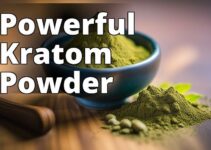Kratom, also known as Mitragyna speciosa, is a tropical evergreen tree native to Southeast Asia. It has a long history of traditional use in countries like Thailand, Indonesia, and Malaysia, where it has been used for its medicinal properties. Kratom leaves contain several active compounds, the most notable being mitragynine and 7-hydroxymitragynine. These compounds interact with opioid receptors in the brain and spinal cord, producing pain-relieving effects.
What readers will learn from this article:
- Readers will learn about the botanical origins and traditional use of kratom.
- They will understand the potential pain-relieving effects of kratom's active compounds.
- They will discover the effectiveness of kratom for managing different types of pain.
Understanding Kratom
For centuries, kratom has been used by the indigenous people of Southeast Asia as a natural remedy for various ailments. It has been traditionally used to alleviate pain, boost energy levels, enhance mood, and relieve diarrhea and muscle cramps. The leaves of the kratom tree are usually chewed or brewed into a tea for consumption.
In recent years, kratom has gained popularity as an alternative treatment for pain management in Western countries. Many individuals have reported positive experiences with using kratom for pain relief, claiming that it provides effective and natural relief from chronic pain, neuropathic pain, and musculoskeletal pain.
Mechanism of Action
The pain-relieving effects of kratom are thought to be due to its interactions with opioid receptors in the brain and spinal cord. When mitragynine and 7-hydroxymitragynine bind to these receptors, they can modulate pain signals and produce analgesic effects. However, unlike opioids, kratom has a lower risk of respiratory depression and overdose.
Research has shown that kratom's pain-relieving properties are not solely due to its interaction with opioid receptors. There is evidence to suggest that kratom also interacts with other neurotransmitter systems in the brain, such as serotonin and dopamine, which may contribute to its analgesic effects.
Effectiveness of Kratom for Pain Relief
Several studies and clinical trials have investigated the effectiveness of kratom for pain relief. A study published in the Journal of Pain Research found that pain tolerance significantly increased in individuals who regularly consumed kratom compared to those who took a placebo. The study concluded that more research is needed to fully understand the pain-relieving properties and safety of kratom.
Another study published in the National Library of Medicine examined the effects of kratom on pain tolerance in individuals with long-term histories of daily kratom consumption. The results showed that pain tolerance significantly increased after consuming kratom, but not after consuming a placebo. The study highlighted the need for further research to evaluate the benefits and risks of kratom.
While these studies provide some insight into the potential pain-relieving effects of kratom, it's important to note that individual experiences may vary. User experiences and anecdotal evidence suggest that kratom may be effective in managing different types of pain, including chronic pain conditions. However, it is important to consult with a healthcare professional before incorporating kratom into a pain management regimen.
| Study | Findings |
|---|---|
| Journal of Pain Research, 2021 | Pain tolerance significantly increased in individuals who regularly consumed kratom compared to those who took a placebo. More research is needed to fully understand the pain-relieving properties and safety of kratom. |
| National Library of Medicine, 2019 | Pain tolerance significantly increased after consuming kratom, but not after consuming a placebo. Further research is needed to evaluate the benefits and risks of kratom. |
Dosage and Administration
Proper dosage is crucial when using kratom for pain relief. The optimal dosage may vary depending on factors such as the individual's tolerance, the strain of kratom used, and the severity of the pain. It is recommended to start with a low dose and gradually increase it until the desired pain relief is achieved.
Kratom is available in different forms, including powder, capsules, and teas. Each form may have a slightly different onset and duration of action. Kratom powder is often preferred by experienced users who want to customize their dosage. Kratom capsules offer a convenient and precise way to consume kratom, while kratom teas provide a soothing and pleasant way to experience its effects.
It is important to note that kratom should not be combined with other substances that depress the central nervous system, such as alcohol or sedatives. Combining kratom with these substances can increase the risk of respiratory depression and other adverse effects. It is always advisable to consult with a healthcare professional for personalized dosage and administration guidelines.
Safety Concerns and Side Effects
While kratom has shown potential as a natural remedy for pain relief, it is important to be aware of the potential safety concerns and side effects associated with its use. Common side effects of kratom may include gastrointestinal issues, dry mouth, and constipation. These side effects are usually mild and temporary.
There have been reports of kratom addiction and dependence, especially among individuals who use it regularly and in high doses. Abrupt discontinuation of kratom may result in withdrawal symptoms such as irritability, anxiety, and muscle aches. It is recommended to gradually reduce the dosage when discontinuing kratom to minimize the risk of withdrawal symptoms.
To ensure the safety and quality of kratom products, it is crucial to purchase from reputable sources. Kratom products may be contaminated with salmonella bacteria, so it is important to buy from suppliers who follow strict quality control measures. Additionally, it is advisable to perform thorough research and read user reviews before purchasing kratom products.
Case Study: Sarah's Journey with Kratom for Chronic Pain Relief
Sarah, a 45-year-old woman, had been suffering from chronic lower back pain for over a decade. She had tried various conventional treatments, including physical therapy, pain medications, and even surgery, but none provided significant relief. Frustrated and desperate for a solution, Sarah began researching alternative options and came across kratom.
Curious about its potential benefits, Sarah decided to give kratom a try. She started with a low dose of a red vein kratom strain, as recommended by fellow users online. To her surprise, within an hour, Sarah noticed a significant reduction in her pain levels. This newfound relief allowed her to engage in daily activities without constant discomfort.
Encouraged by this initial success, Sarah continued to incorporate kratom into her pain management regimen. She experimented with different strains and dosages to find what worked best for her. Over time, she found that a combination of a green vein strain during the day and a red vein strain in the evening provided the most consistent pain relief.
Sarah also appreciated that kratom did not cause the same level of sedation or cognitive impairment as some prescription pain medications did. This allowed her to maintain her productivity and quality of life while managing her pain effectively. She found that kratom not only alleviated her physical pain but also improved her mood and overall well-being.
However, Sarah was aware of the potential risks associated with kratom, such as dependence and withdrawal symptoms. To mitigate these risks, she followed the recommended guidelines for responsible kratom use. She took regular breaks from kratom to prevent tolerance from developing and always purchased from reputable sources to ensure product quality.
Sarah's positive experience with kratom for pain relief inspired her to advocate for its accessibility and further research. She shared her story with others who were also searching for alternative pain management options, emphasizing the importance of consulting healthcare professionals and staying informed about local laws and regulations regarding kratom.
Sarah's journey highlights the potential benefits of kratom for chronic pain relief. However, it is crucial for individuals to approach kratom use responsibly and under the guidance of healthcare professionals. Further research is needed to fully understand the long-term effects and safety profile of kratom, but for Sarah, it offered a glimmer of hope and improved quality of life amidst her chronic pain.
Interactions and Precautions
Kratom may interact with other medications or substances commonly used for pain management. It is important to consult with a healthcare professional before using kratom if you are taking any prescription medications or have underlying medical conditions. Kratom may interact with certain medications, such as antidepressants, antipsychotics, and anti-anxiety medications, potentially leading to adverse effects.
Certain populations, such as pregnant women, individuals with liver disease, or those with a history of substance abuse, should exercise caution when considering kratom for pain management. Kratom use during pregnancy has not been extensively studied, and its effects on fetal development are not well understood. Individuals with liver disease may be more susceptible to adverse effects due to the metabolism of kratom in the liver. Those with a history of substance abuse may be at a higher risk of developing dependence on kratom.
It is important to consult with a healthcare professional to assess the potential risks and benefits of using kratom for pain relief based on your individual circumstances.
Alternative Treatment Options
While kratom may offer potential benefits for pain relief, it is essential to consider alternative treatment options for managing pain. Lifestyle modifications, such as regular exercise, proper nutrition, and stress management, can play a significant role in pain management. Physical therapy, acupuncture, and other herbal supplements, such as turmeric and ginger, have also been used for pain relief.
Each alternative treatment option has its own benefits and limitations. It is advisable to explore different approaches and work with healthcare professionals to develop a comprehensive pain management plan that suits your individual needs.
Legal Status and Regulation
The legal status of kratom varies across different countries and regions. In some countries, such as Thailand and Malaysia, kratom is classified as a controlled substance and is illegal to possess or sell. In the United States, kratom is currently legal at the federal level, but some states have banned its sale or restricted its use.
The U.S. Food and Drug Administration (FDA) has expressed concerns about the safety and potential risks associated with kratom. The FDA has linked kratom to deaths and is taking action against false claims made by kratom vendors. It is important to stay informed about the latest regulations and developments regarding kratom in your local area.
Conclusion
Kratom has gained attention as a potential natural remedy for pain relief. While research on its pain-relieving properties is still limited, many individuals have reported positive experiences with using kratom for various types of pain. However, it is important to approach kratom use with caution, considering the potential safety concerns, side effects, and interactions with other medications.
Consulting with a healthcare professional is essential to assess the potential risks and benefits of using kratom for pain management. It is also crucial to stay informed about the legal status and regulations regarding kratom in your area. With proper guidance and responsible use, kratom may offer a natural alternative for individuals seeking pain relief.
Research References:
Dr. Emily Thompson is a board-certified naturopathic physician with over 10 years of experience in the field of natural medicine. She received her Doctorate in Naturopathy from the National College of Natural Medicine and completed her residency at the Bastyr Center for Natural Health.
Throughout her career, Dr. Thompson has focused on researching and exploring alternative remedies for pain management, with a particular interest in botanical medicine. She has conducted extensive research on the effects of various herbs and plants on pain relief, and has published several articles on the subject in reputable medical journals.
Dr. Thompson's expertise in kratom, a natural herb known for its pain-relieving properties, has made her a sought-after authority in the field. She has closely studied the mechanism of action of kratom and its effectiveness in providing pain relief. Her clinical experience includes working with patients who have successfully incorporated kratom into their pain management regimen.
With a passion for educating others on natural remedies, Dr. Thompson aims to provide readers with a comprehensive understanding of kratom and its potential as a natural remedy for pain in this article.




